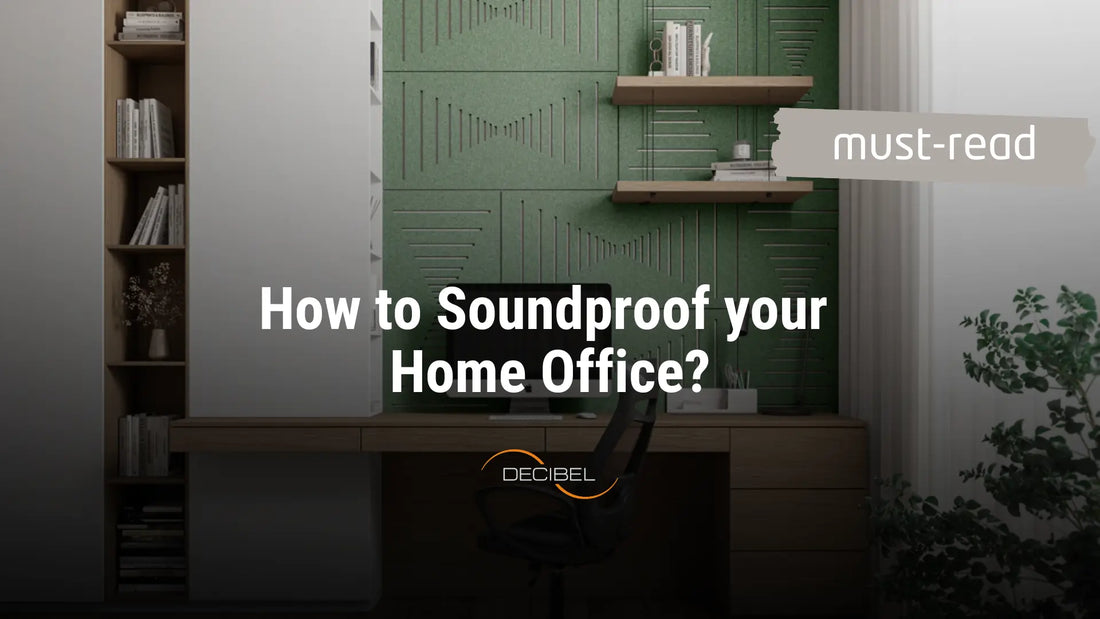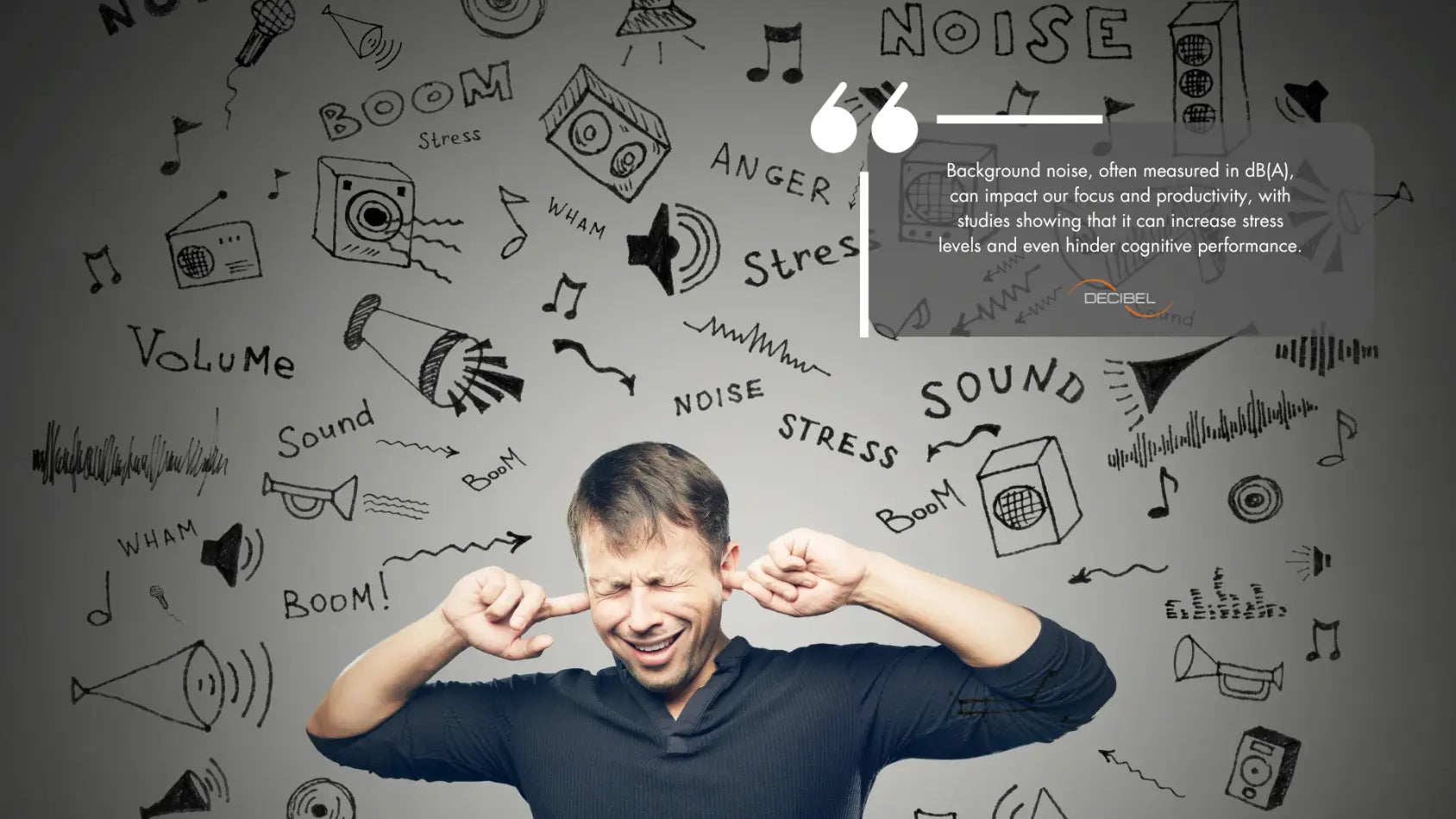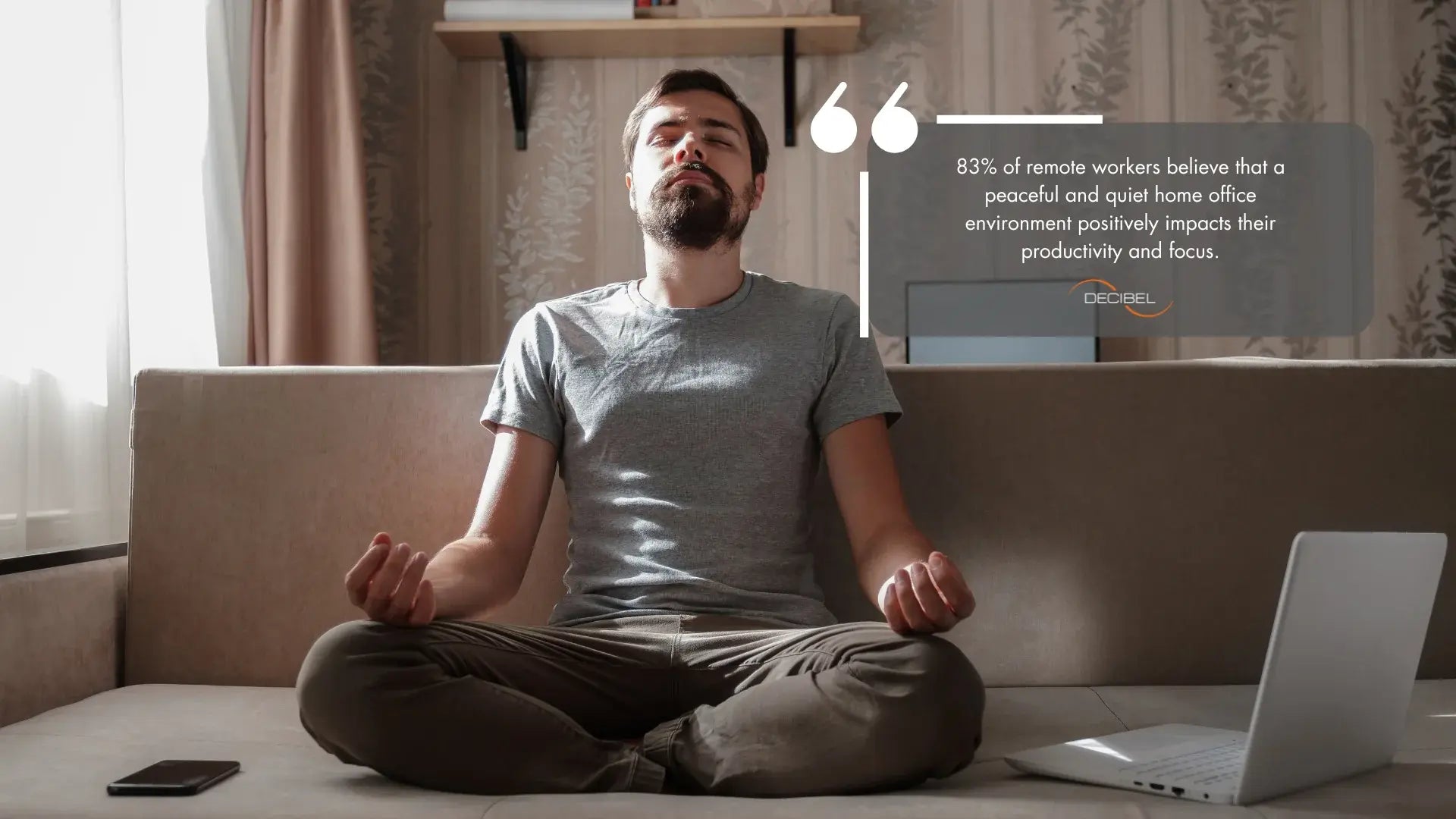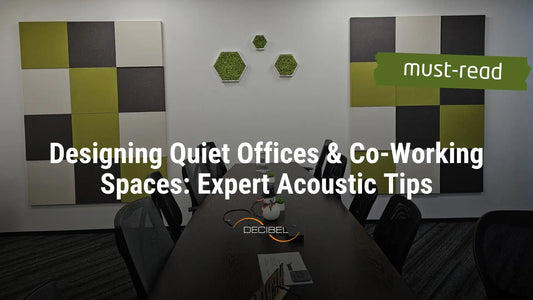
How to Soundproof your Home Office?
Diana TzonevskaShare
📖 Reading time: 9 min and 56 sec
Working from home provides the comfort and flexibility of being your own boss, but it can also be distracting and frustrating if you're surrounded by noise. For those who need a peaceful environment to focus and be productive, soundproofing the home office is a must. Whether it's the sounds of kids playing or dogs barking, taking the necessary steps to eliminate distractions can lead to a more efficient and stress-free work-from-home experience.
Before we dive into the details, what about a quick walk into the factory where we engineer silence? Click the play button below and have a look behind the scenes with us.
7 Most Annoying Home Noises That Disrupt Focus
A recent thematic analysis of the indoor soundscape for work found that home-office workers are frequently disrupted by both continuous and impulsive noises - from internal (in your home) noises like next-room noises, loud appliances, etc. and external (different neighbours' noises - voices, steps, moving furniture, dropping things, etc.) - all of them leading to reduced concentration, increased stress hormones, and even long-term health effects such as sleep disturbances and elevated blood pressure
In Europe, about 65 % of the population is exposed to ambient sound levels above 55 dB during the day, and nearly 17 % above 65 dB, making effective home sound control critical
By contrast, in Tokyo many residents resort to wearing earplugs outdoors to cope with relentless city noise, highlighting cross-cultural challenges for homeworkers.
#1 Whining Children (~70 dB)
Whining combines both high frequency and unpredictable tonal shifts, making it one of the most annoying sounds recorded in laboratory settings. (And NO, it doesn't help if the children are yours and you love them!) A study found that adult participants made more errors on cognitive tasks when exposed to whining versus mechanical noises or even a chainsaw growl. At around 70 dB - comparable to busy traffic - it elevates cortisol and reduces short-term memory performance, leading to frequent breaks in concentration.
#2 Vacuum Cleaner (60–80 dB)
Domestic vacuums typically produce between 60 and 80 dB, with upright models hitting 70–80 dB on average. Continuous mechanical noise fatigues the brain’s auditory processing centres, increasing irritability and reducing the ability to sustain attention on complex tasks for more than 20–30 minutes without a break.
#3 High Heels from Upstairs (~65 dB)
In many apartments, the rhythmic “click-clack” of high-heeled shoes on wooden or tiled floors can register around 65 dB - comparable to the roar of a vacuum cleaner close to your ears. This type of impact noise transmits structurally through walls and ceilings, causing sudden jolts that repeatedly break concentration. Neurologically, these abrupt, patterned impulses engage the brain’s salience network (designed to detect and respond to unexpected events), thereby, elevating stress hormones like cortisol and making it difficult to sustain deep focus or achieve restful sleep in the night.
#4 Dog Barking (60–100 dB)
A single dog's bark can reach 80 dB and some breeds up to 100 dB—louder than a vacuum cleaner. Its sudden onset startles the parasympathetic nervous system, triggering adrenaline release and breaking concentration cycles. Extended exposure can contribute to chronic stress symptoms.
#5 Dripping Tap (~40 dB)
Though only about 40 dB, the rhythmic “plink” of a dripping tap is highly annoying due to its repetition and mid-frequency content of around 500–1 kHz. Each drop can subconsciously cue the brain’s salience network, pulling focus away and increasing overall stress over time.
#6 Door Slams (~96 dB)
A door slammed two feet away can peak at 96 dB - comparable to heavy traffic horns. These transient sounds can cause a temporary threshold shift in hearing sensitivity and disrupt the so-called “flow state,” requiring several minutes to refocus on cognitively demanding work.
#7 Phone Notifications (~90 dB)
Ringtones and notification alerts can exceed 90 dB, especially if set to loud settings. These high-pitched, transient sounds hijack attention networks, prompting immediate shifts in task-related brain activity and a noticeable drop in productivity, along with brief heart rate spikes.
If you think all these sounds are not that bad in real life, GOOD LUCK having your quality work done in such a noisy environment (especially in a prolonged time).
Why Soundproofing Your Home Office Matters for Your Health and Wellbeing
Soundproofing your workspace is about far more than silencing distractions—it's a step toward improving your mental health, focus, and overall quality of life. Noise pollution, even at moderate levels, has significant impacts on our brain and body. Here's why a quieter environment can transform not only your work productivity but also your overall wellbeing:
The Impact of Noise on the Brain
- Increased Stress Levels: Prolonged exposure to noise activates the brain's "fight or flight" response, triggering higher cortisol (stress hormone) levels. This can leave you feeling anxious, tense, and mentally exhausted.
- Cognitive Overload: The brain is constantly filtering sounds. Background noises, such as traffic or household sounds, drain cognitive resources, making it harder to focus and solve problems.
- Impaired Memory: Studies show that even low-level noise disrupts working memory and learning processes. Tasks that require concentration become far more challenging.
Noise and Its Effect on Productivity
- Reduced Focus: Unwanted sounds, like distant conversations or barking dogs, can break your concentration. Once distracted, it can take up to 20 minutes to regain the same level of focus.
- Lower Efficiency: In noisy environments, you work slower and make more mistakes because your mind is constantly trying to “tune out” the chaos.
- Impaired Creativity: Noise interrupts the "flow state"—that highly productive, immersive zone where your creativity flourishes. A quiet space allows your ideas to surface naturally and without interruption.
The Link Between Noise and Overall Wellbeing
- Sleep Disruption: Excessive noise can negatively impact sleep quality, leading to fatigue, irritability, and weakened immune function.
- Mood and Mental Health: Noise pollution has been linked to increased anxiety, irritability, and even symptoms of depression. A peaceful workspace can create a more positive mindset.
- Physical Health: Chronic noise exposure has been associated with high blood pressure, heart conditions, and hearing loss over time. Reducing noise helps protect your long-term health.
Your Home Office as Part of Your Health Ecosystem
Soundproofing your home office is not just a "work upgrade"—it's a holistic step toward improving both body and mind. By creating a quiet, calm environment, you:
- Boost Mental Clarity: Your brain can focus on tasks without wasting energy filtering out distractions.
- Enhance Work-Life Balance: A peaceful workspace means less stress during work hours, allowing you to “switch off” and relax more effectively once the day ends.
- Support Overall Health: Better concentration, reduced stress, and improved productivity lead to better sleep, mood, and physical well-being.
Why Now Is the Time to Invest in Soundproofing
Your home office is not just a space for work—it’s part of your daily life and your health ecosystem. The sounds you experience affect your focus, energy, and mental state throughout the day. By soundproofing your space, you:
- Take control of your environment
- Eliminate unnecessary stressors
- Create a supportive space where you can thrive
You got the point, right? Let's first examine your current situation.
The first question to ask is: Why is your home office plagued by noise? Noise often finds its way through hard surfaces that reflect sound, such as bare floors or uncarpeted walls. Hard materials like wood and tile floors cause soundwaves to bounce around, increasing the overall noise level in a room. This can contribute to noise pollution, a phenomenon defined by the World Health Organisation (WHO) as unwanted or harmful sound that disrupts normal activity and causes long-term health effects.
But don't worry; simple changes like adding soft, sound-absorbing materials such as rugs or acoustic panels can make a significant difference.
Identifying where the noise is coming from is the first step to a successful sound reduction project in your home office.
This will help you target the problem and find a solution that works. So, without further ado, let's get down to the most effective methods of soundproofing your home office.
Practical Tips to Make Your Home Office More Quiet
1. Soundproof Your Windows
Windows are one of the most common entry points for noise in a home office. Soundproofing curtains are designed to block external noise while also improving the room’s acoustic quality. These curtains are made of dense, thick fabric, often layered with materials like mass-loaded vinyl to reduce noise effectively. According to scientific studies, adding mass to windows reduces sound transmission by 30-50%, depending on the materials used.
Additionally, they also provide privacy and insulation, helping to regulate temperature and keep the room more comfortable.

Overall, incorporating soundproofing curtains in your home office can lead to a more productive, comfortable, and peaceful work environment.
If the soundproof curtain does not provide sufficient sound insulation, you can consider replacing the existing windows with ones that have a better sound insulation index, or you can double your windows. In most cases, the installation of a second window will give a much better result in terms of sound insulation and thermal insulation than the replacement of the original window. Research shows that well-installed double-glazed windows can reduce outside noise by 20 to 40 dB.
A tip from us: most of the studios are done with double windows and doors, so you can learn from the professionals and install a second window as well.
2. Soundproof Your Doors
The next significant source of noise leakage is doors. Sound can easily slip through gaps around door frames. A simple but effective solution is installing weatherstripping, which blocks gaps with noise-absorbing materials like rubber or silicone. Studies indicate that sealing air gaps can reduce sound transmission by up to 10 decibels, depending on the thickness of the weatherstripping used.
Additionally, installing a soundproof blanket behind the door can further reduce noise, particularly if you're looking for a quick and inexpensive solution. For more serious soundproofing, adding a second door, similar to what’s done in recording studios, can be effective. The extra layer helps block airborne noise and vibrations.
The last very effective option is to install a second door, similar to the example with the windows.
By taking these simple steps, you can create a peaceful and productive work environment in your home office.
3. Soundproof Your Walls
If you experience noise coming from the neighbouring room, soundproofing your wall is the simplest solution. Effective soundproofing requires using specific materials that prevent noise transmission. When searching for soundproofing systems and materials, consider those specially designed for this purpose and developed by acousticians to ensure maximum effectiveness.
For example, using a system like DECIBOARD, which incorporates high-density gypsum fibre panels with a 9-point contact system, can reduce airborne noise by 15-30 dB.
Avoid using systems that consist of multiple components like metal studs, hangers, wool, gypsum board, etc., as incorrect installation can lead to errors. Keep in mind that gypsum board and wool on metal studs were initially created for internal thermal insulation.
After installing the soundproofing, it's recommended to finish the wall with acoustic panels for even better results. Integrating soundproofing and acoustic treatment yields optimal results.

4. Add Rugs and Carpets to Soundproof Floors
Hard floors like wood or tile contribute to noise reflection, which amplifies sound within a room. Using rugs or carpets is a cost-effective way to dampen sound. Thicker materials, like wool, provide better absorption, reducing noise transmission between floors and improving the room's overall acoustics. A study on textile materials' sound absorption properties found that carpets with dense fibres can reduce airborne sound by 20-30%.
In addition to absorbing noise, rugs and carpets also help to improve the acoustics of the room by reducing echoes and improving sound clarity. Consider placing a rug or carpet under a desk or in areas where you do a lot of work to help reduce noise levels and improve the overall sound quality of your workspace.
Remember, a rug or a wall-to-wall carpet is not a complete floor soundproofing solution but can be very effective for taming down some decibels that might trigger you. It is also effective to insulate the noises from furniture movement and light steps.
5. Soundproof Your Ceiling
Soundproofing your ceiling should be the last thing on your list to soundproof because it requires investment and time. If you’re getting noise from the room above then you need to soundproof the ceiling.
To soundproof your ceiling, it's advisable to install a soundproofing system specifically designed for ceilings. The challenge is to securely connect the system to the ceiling with minimal contact points to prevent noise transmission and ensure safety during earthquakes. Drywall systems with metal studs are not effective, as metal studs easily transmit both structural and airborne noise.
Look for systems that have special installation anchors that do not transmit vibration and sound, such as C- MUTE SYSTEM.
Our pro tip will be to finish off the soundproofed ceiling with acoustic panels for even better results. Acoustic panels will dampen any reverberation left and can add up to 3, to 4 decibels of additional soundproofing which in some cases might be just what you are left off to treat to achieve your optimal quietness.

So there you have it, some practical tips on how to soundproof your home office and make it a productive and peaceful space to work in. By identifying the source of the noise and implementing some simple solutions such as soundproof curtains, weatherstripping, rugs or carpets, and even soundproofing your walls and ceiling, you can create a quieter and more comfortable environment for you to concentrate and be more efficient. With the right tools and techniques, you can say goodbye to distractions and hello to a more focused and stress-free work-from-home experience.
Happy soundproofing!
Suggested Bibliographic Sources for Further Reading:
-
Schulte-Fortkamp, B., & Fiebig, A. (2016). Soundscape and the Built Environment. CRC Press.
-
World Health Organization (WHO). (2018). Environmental Noise Guidelines for the European Region. WHO Regional Office for Europe.
-
Crocker, M. J. (2007). Handbook of Noise and Vibration Control. John Wiley & Sons.
-
Rychtáriková, M., & Vermeir, G. (2013). "Sound Transmission and Sound Insulation in Buildings: A Practical Approach". Building Acoustics, 20(2), 85-104.
-
Environmental Protection Agency (EPA). (1978). Levels of Environmental Noise Requisite to Protect Public Health and Welfare with an Adequate Margin of Safety.
-
Basner, M., Babisch, W., Davis, A., Brink, M., Clark, C., Janssen, S., & Stansfeld, S. (2014). "Auditory and Non-Auditory Effects of Noise on Health". The Lancet, 383(9925), 1325-1332.
-
World Health Organization (WHO). (2011). Burden of Disease from Environmental Noise: Quantification of Healthy Life Years Lost in Europe. WHO Regional Office for Europe.
-
Kang, J., & Schulte-Fortkamp, B. (2018). Soundscape and the Built Environment: Theories and Applications. CRC Press.
-
Ising, H., & Kruppa, B. (2004). "Health Effects Caused by Noise: Evidence in the Literature from the Past 25 Years". Noise and Health, 6(22), 5-13.
-
Aletta, F. et al. The actual and ideal indoor soundscape for work, relaxation and play. Int. J. Environ. Res. Public Health (2021)
-
Dogster. How Loud Is a Dog’s Bark in Decibels? (2025)
-
Scientific American. Quiet! Our Loud World Is Making Us Sick (2023)
-
WeekPlan. 11 Ways Noisy Environment Can Affect Productivity (2024)




